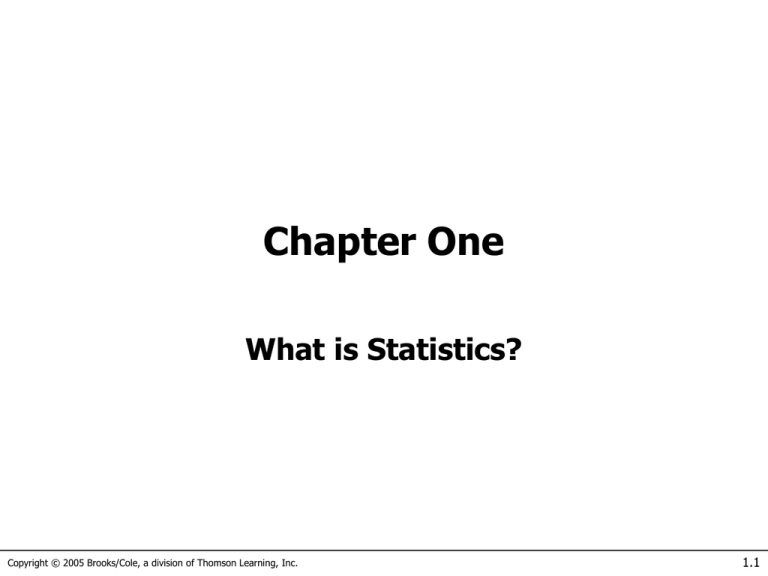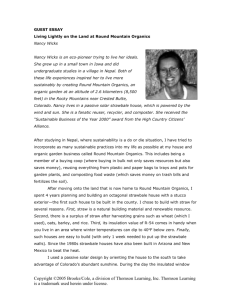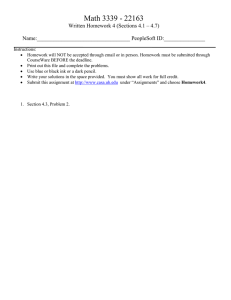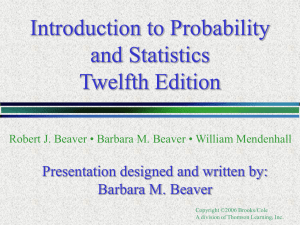Chapter 1 - What is Statistics?
advertisement

Chapter One What is Statistics? Copyright © 2005 Brooks/Cole, a division of Thomson Learning, Inc. 1.1 FYI – Past Grades in This Statistics Course 84 73 22 64 39 62 50 43 23 52 71 58 38 44 26 36 66 46 58 41 95 80 57 66 44 86 38 43 49 38 99 61 86 23 25 74 40 58 66 60 67 25 82 65 42 75 93 64 99 21 42 34 53 70 64 97 35 37 21 52 73 99 51 81 44 86 91 86 54 37 99 51 71 86 61 91 54 43 74 38 79 94 49 69 93 83 57 70 58 74 52 45 43 51 74 60 73 26 74 32 66 42 54 82 64 69 25 80 86 70 81 37 71 48 76 20 20 58 64 34 31 79 37 47 55 100 38 60 35 97 71 65 88 56 75 56 95 52 20 92 64 49 53 85 67 79 59 38 58 68 67 87 28 34 63 39 37 62 36 85 72 47 56 87 51 92 58 47 59 45 65 80 89 80 99 79 45 85 100 32 65 100 22 99 57 47 92 75 50 31 41 45 65 86 30 27 86 95 53 88 35 59 76 24 80 79 86 71 25 56 91 66 70 66 71 89 27 98 80 30 99 46 49 95 21 81 32 77 97 26 30 42 46 65 98 99 56 62 29 62 51 46 40 46 44 32 78 66 64 47 88 30 29 84 73 34 35 86 74 99 82 72 23 44 67 86 24 95 33 67 24 80 49 96 60 95 98 23 32 45 58 51 47 82 88 68 52 90 69 87 41 66 95 76 25 23 87 28 99 65 72 44 70 27 66 46 77 67 38 55 96 79 34 40 44 46 75 54 48 44 98 61 87 44 25 40 89 91 37 72 68 47 28 64 82 27 54 95 72 83 50 80 78 22 60 56 99 68 52 31 84 74 42 40 46 23 22 21 83 40 47 94 57 83 29 30 28 56 97 96 38 28 71 37 70 65 63 74 92 67 45 64 34 97 78 36 96 82 57 93 25 77 34 92 78 71 73 39 82 31 59 90 84 42 95 58 84 89 86 72 69 54 54 48 45 96 85 70 92 95 87 55 30 64 77 21 95 47 45 97 63 62 22 89 27 26 43 66 100 35 74 35 91 68 74 58 33 52 27 31 45 73 24 51 26 98 76 76 27 39 57 96 94 71 92 23 56 69 54 87 92 68 83 96 96 78 87 55 97 78 38 92 47 97 53 56 22 67 75 21 31 82 47 66 72 31 97 76 46 42 94 70 73 78 55 90 81 47 39 84 61 33 43 89 87 23 69 83 48 99 51 66 68 27 62 35 32 98 23 92 30 99 93 39 53 92 69 61 66 44 45 22 41 69 69 92 47 77 20 63 94 66 86 50 59 87 52 60 22 71 34 28 95 64 54 99 20 29 27 26 40 68 79 76 21 21 72 33 22 24 25 47 80 48 55 50 77 79 96 67 28 76 28 54 45 91 48 70 83 87 54 43 69 93 37 70 46 71 29 55 64 44 32 89 46 53 51 46 80 49 37 28 31 44 40 61 84 71 20 85 51 41 99 71 94 44 63 31 51 60 45 71 23 45 44 24 36 63 62 84 88 89 38 26 93 72 75 49 72 99 42 93 40 77 62 40 55 62 47 98 70 36 68 24 22 94 89 37 97 82 42 54 46 39 61 68 24 21 95 47 93 78 85 82 37 22 74 75 80 61 25 31 66 24 28 75 77 43 76 47 25 44 63 73 34 30 68 79 75 74 30 62 56 91 98 91 46 70 85 35 69 23 82 65 26 72 88 85 70 25 88 89 62 44 97 97 53 74 24 49 78 38 27 89 60 23 29 97 84 48 94 41 37 41 40 82 92 23 38 68 25 89 95 41 58 93 99 42 41 54 51 87 74 97 47 72 26 79 43 81 99 32 29 80 50 48 48 80 91 23 99 30 26 46 68 89 66 94 65 51 22 25 50 83 26 29 100 94 45 62 52 92 72 57 91 22 52 41 95 64 21 47 77 92 47 83 34 69 68 71 90 86 95 73 44 61 69 91 92 37 57 90 40 49 35 51 58 75 44 92 28 37 47 84 63 42 34 78 29 72 36 41 80 56 60 96 80 23 41 35 77 28 37 57 69 92 42 65 96 66 45 21 25 67 95 65 64 45 64 88 Copyright © 2005 Brooks/Cole, a division of Thomson Learning, Inc. 90 26 72 30 79 50 53 39 90 39 94 87 54 68 74 70 62 87 65 22 22 56 90 72 77 53 88 58 43 25 96 66 89 78 72 59 28 90 97 40 24 96 61 20 62 83 40 40 33 77 88 52 31 33 78 72 66 47 62 72 34 88 81 43 31 69 59 79 25 98 46 48 24 43 69 84 95 58 72 34 65 85 32 44 42 80 75 35 60 93 50 64 54 37 72 62 92 30 33 53 64 34 83 81 89 90 91 58 78 63 99 38 97 64 53 57 92 65 53 43 42 77 85 99 86 54 58 37 58 96 41 83 30 56 77 23 33 73 37 93 55 45 97 68 21 25 54 86 58 30 57 51 60 36 67 46 96 46 42 83 29 30 95 65 33 24 31 40 45 34 85 75 59 69 64 48 35 22 99 94 64 41 53 26 49 34 52 36 50 54 71 57 71 67 87 84 97 39 83 35 57 39 88 70 97 40 32 76 87 22 92 95 31 56 86 79 61 95 86 78 76 55 74 63 69 28 63 45 25 59 93 76 28 57 46 67 20 77 71 55 90 88 95 32 87 35 24 77 94 28 51 52 62 38 87 32 82 96 30 71 34 81 44 78 61 40 36 40 81 97 27 22 83 99 41 22 25 69 20 61 63 30 56 58 80 83 78 29 92 85 28 52 30 66 49 91 93 95 43 61 90 96 41 96 89 62 59 96 24 48 57 63 80 59 86 73 97 28 75 54 74 63 82 57 73 93 24 95 28 58 24 25 66 56 88 53 96 69 67 77 73 57 76 46 80 97 75 50 61 99 85 38 52 38 57 57 49 80 50 68 71 93 51 75 49 21 84 28 83 51 75 49 28 54 39 36 43 73 40 72 41 94 77 52 20 80 66 28 87 81 69 94 92 43 52 39 74 25 53 45 79 23 46 74 56 29 80 68 44 40 38 90 74 55 36 60 64 97 96 45 85 78 27 36 26 34 89 82 48 92 97 82 25 80 100 28 96 79 67 54 53 55 29 52 66 23 22 70 93 25 76 21 92 32 36 29 88 82 69 27 94 65 42 39 22 32 47 67 45 33 99 97 57 90 72 36 96 92 52 48 62 26 61 37 86 55 24 86 20 51 77 30 72 87 71 85 75 73 59 39 56 55 78 75 95 67 51 95 52 71 69 72 47 90 82 33 88 55 60 89 33 39 30 57 88 50 69 73 73 39 41 74 92 40 91 33 67 38 81 98 24 43 27 51 46 61 29 22 22 33 30 78 46 30 79 52 95 29 55 92 32 92 39 97 81 93 24 42 42 94 94 99 89 62 65 39 44 83 83 92 27 20 43 51 77 72 48 70 98 46 89 31 60 96 42 41 48 23 89 55 29 77 60 44 85 86 59 25 87 61 44 51 64 91 28 86 83 42 89 26 97 87 84 59 84 84 56 27 76 49 37 44 71 36 81 41 88 65 91 79 21 25 23 77 28 23 61 65 87 64 30 21 90 93 36 76 81 95 67 69 45 61 24 57 74 56 61 20 34 73 82 30 100 82 49 29 33 97 56 95 58 90 97 88 78 72 84 93 93 32 30 81 74 37 88 59 84 28 38 69 72 43 29 55 78 94 20 27 66 83 31 94 56 51 30 39 40 44 44 38 49 85 51 21 33 37 92 38 33 75 98 36 80 92 21 91 65 29 89 38 62 96 68 49 55 91 99 41 39 36 47 72 63 28 88 30 91 27 28 57 20 32 69 20 78 33 75 64 48 85 82 49 63 74 97 49 50 56 65 43 64 43 92 38 72 37 29 21 66 82 37 98 31 73 29 70 72 71 97 66 35 60 84 91 59 44 62 87 30 59 29 33 59 52 22 36 80 29 64 97 81 54 96 88 71 53 49 27 86 68 41 73 21 84 61 21 53 64 34 38 92 35 81 97 69 61 44 97 40 29 53 91 24 31 86 82 91 69 74 76 89 37 95 69 58 30 89 82 59 33 38 97 40 65 83 80 35 84 78 96 49 67 45 32 34 21 78 54 36 79 92 24 33 50 62 63 99 20 41 70 55 29 76 52 92 80 25 89 44 38 61 93 44 98 79 48 92 67 82 29 66 43 96 30 31 96 66 72 29 95 32 50 91 50 40 23 47 28 27 77 34 48 64 79 89 92 22 40 38 97 77 41 59 69 48 27 29 77 73 74 24 43 80 89 73 100 56 74 21 67 77 98 85 68 34 27 59 27 90 75 61 61 97 80 76 83 78 68 78 55 66 34 77 85 38 44 21 60 23 34 33 88 56 44 59 42 74 21 27 44 92 32 31 91 63 80 86 55 33 70 23 29 60 55 78 75 31 51 90 26 85 64 28 53 40 82 88 89 83 45 43 97 58 95 82 72 92 86 91 90 44 26 63 86 56 70 97 37 26 80 85 90 24 51 27 82 92 70 99 31 73 96 82 40 83 70 87 53 42 35 83 98 88 21 78 59 47 29 76 24 24 96 34 76 53 58 73 98 76 34 88 70 31 34 56 21 43 83 51 99 64 55 78 71 28 31 75 70 79 39 31 65 31 99 78 88 83 84 69 40 69 22 95 25 26 60 76 88 27 67 57 92 51 96 70 42 71 88 37 51 59 24 96 65 51 60 21 73 22 39 87 37 36 67 28 54 90 68 50 36 73 42 32 46 58 80 29 87 37 77 47 55 75 97 80 27 64 21 76 78 55 89 70 28 37 93 88 76 45 99 78 86 68 29 74 71 49 35 75 98 40 23 57 46 55 23 47 29 58 73 82 31 35 87 61 88 32 92 53 30 81 45 82 77 97 87 57 46 70 57 61 43 56 91 55 92 74 74 30 47 32 31 95 97 43 38 46 75 61 87 27 97 54 94 50 56 54 58 72 39 33 86 41 75 97 23 95 54 69 63 66 59 98 76 99 61 22 77 96 32 82 59 36 59 55 73 75 80 78 90 33 63 99 62 22 47 53 24 56 27 90 98 54 46 47 84 68 67 81 87 26 66 76 78 90 80 68 49 99 87 69 72 26 73 34 78 84 87 26 90 77 94 39 29 92 46 28 44 27 80 68 34 49 37 70 42 85 86 58 29 68 31 97 92 94 48 67 54 72 75 23 79 55 35 94 23 97 67 65 65 45 51 88 78 56 91 52 43 87 67 73 78 33 58 36 71 37 68 36 50 49 67 100 59 56 68 47 32 33 40 92 66 73 55 87 45 43 62 49 91 84 28 59 64 52 64 38 63 46 34 62 26 28 94 88 91 47 84 41 53 36 88 43 72 65 81 41 62 76 36 24 37 43 77 41 91 84 91 61 41 99 43 42 90 42 97 47 77 58 66 76 62 80 47 75 53 83 22 29 46 28 32 74 89 47 45 48 32 91 67 23 83 60 25 34 98 22 64 75 81 88 87 83 37 86 73 20 23 78 47 86 42 86 37 43 79 81 56 62 66 64 92 70 57 54 77 39 58 36 55 81 62 40 87 33 61 33 43 52 99 99 85 60 65 28 81 41 86 78 26 84 81 88 74 94 66 94 57 54 24 57 20 23 44 36 82 34 70 47 94 65 84 79 68 98 53 39 53 27 54 25 23 59 85 48 89 81 45 91 92 80 48 88 74 92 24 81 49 82 47 1.2 FYI – Past Grades in This Statistics Course Grades 0-10 10-20 20-30 30-40 40-50 50-60 60-70 70-80 80-90 90-100 Total = Frequency Relative Freq 0 0.000 0 0.000 323 0.129 286 0.114 316 0.126 297 0.119 304 0.122 324 0.130 319 0.128 331 0.132 2500 Copyright © 2005 Brooks/Cole, a division of Thomson Learning, Inc. Percent 0.0% 0.0% 12.9% 11.4% 12.6% 11.9% 12.2% 13.0% 12.8% 13.2% Cum Percent 0.0% 0.0% 12.9% 24.4% 37.0% 48.9% 61.0% 74.0% 86.8% 100.0% 1.3 FYI – Past Grades in This Statistics Course 400 200 0 010 10 -2 0 20 -3 0 30 -4 0 40 -5 0 50 -6 0 60 -7 0 70 -8 0 80 -9 90 0 -1 00 Frequency Histogram Final Grade Copyright © 2005 Brooks/Cole, a division of Thomson Learning, Inc. 1.4 In today’s world… …we are constantly being bombarded with statistics and statistical information. For example: Customer Surveys Medical News Political Polls Economic Predictions Marketing Information Scanner Data How can we make sense out of all this data? How do we differentiate valid from flawed claims? Three types of liars! Copyright © 2005 Brooks/Cole, a division of Thomson Learning, Inc. 1.5 What is Statistics? Where does this Data come from? “Statistics is a way to get information from data” Statistics Data Data: Facts, especially numerical facts, collected together for reference or information. Information Information: Knowledge communicated concerning some particular fact. Statistics is a tool for creating new understanding from a set of numbers. Definitions: Oxford English Dictionary Copyright © 2005 Brooks/Cole, a division of Thomson Learning, Inc. 1.6 Key Statistical Concepts… Population — a population is the group of all items of interest to a statistics practitioner. — frequently very large; sometimes infinite. E.g. All 5 million Florida voters who voted in today’s election. Sample — A sample is a set of data drawn from the population. [Part of a population] — Potentially very large, but less than the population. E.g. a sample of 1000 voters exit polled on election day. Copyright © 2005 Brooks/Cole, a division of Thomson Learning, Inc. 1.7 Key Statistical Concepts… Parameter — A descriptive measure of a population. - the true percent of Florida Voters who will vote for Mary Poppins Statistic — A descriptive measure of a sample. - Of the 1000 exit voters polled, 550 indicated that they voted for Mary Poppins or 550/1000 = 0.55 or 55% Copyright © 2005 Brooks/Cole, a division of Thomson Learning, Inc. 1.8 Key Statistical Concepts… Population Sample Subset Parameter Statistic Populations have Parameters, Samples have Statistics. Copyright © 2005 Brooks/Cole, a division of Thomson Learning, Inc. 1.9 Descriptive Statistics… …are methods of organizing, summarizing, and presenting data in a convenient and informative way. These methods include: Graphical Techniques (Chapter 2), and Numerical Techniques (Chapter 4). The actual method used depends on what information we would like to extract. Are we interested in… • Your weight each Monday when you are on a 6 month diet. • The amount of medication in blood pressure pills. •The starting salaries for business students from TCU, SMU, and UTA. •Others… Descriptive Statistics helps to answer these questions… Copyright © 2005 Brooks/Cole, a division of Thomson Learning, Inc. 1.10 Inferential Statistics… Descriptive Statistics describe the data set that’s being analyzed, but doesn’t allow us to draw any conclusions or make any interferences about the data, other than visual “It looks like …..” type statements. Hence we need another branch of statistics: inferential statistics. Inferential statistics is also a set of methods, but it is used to draw conclusions or inferences about characteristics of populations based on data from a sample. Copyright © 2005 Brooks/Cole, a division of Thomson Learning, Inc. 1.11 Statistical Inference… Statistical inference is the process of making an estimate, prediction, or decision about a population based on a sample. Population Sample Inference Statistic Parameter What can we infer about a Population’s Parameters based on a Sample’s Statistics? Copyright © 2005 Brooks/Cole, a division of Thomson Learning, Inc. 1.12 Statistical Inference… Rationale: • Large populations make investigating each member impractical and expensive + it’s been shown that observing 100% of a population is not perfect. • Easier and cheaper to take a sample and make inferences about the population from the sample. However: Such conclusions and estimates are not always going to be correct. For this reason, we build into the statistical inference “measures of reliability”, namely confidence level and significance level. Copyright © 2005 Brooks/Cole, a division of Thomson Learning, Inc. 1.13 Confidence & Significance Levels… The confidence level is the proportion of times that an interval estimate for a population parameter will be correct. E.g. a confidence level of 95% means that, interval estimates based on this form of statistical inference will be correct 95% of the time. I am 95% confident that the “TRUE” mean IQ of female business students at UTA is between 120 and 122. When the purpose of the statistical inference is to test a claim about a population parameter, the significance level measures how frequently a “true claim” is accidently rejected. E.g. a 5% significance level means that, in the long run, a true claim will be rejected 5% of the time. Coin flips should result in 50% heads, on average. A 5% significance level implies that we run a 5% risk of concluding that heads do not occur 50% of the time, on average [even though everyone in this room most likely believes that heads do occur 50% of the time]. Copyright © 2005 Brooks/Cole, a division of Thomson Learning, Inc. 1.14 Confidence & Significance Levels… We use (Greek letter “alpha”) to represent the significance level when testing a claim about a population parameter , and 1– to represent the confidence level when we wish to estimate a population parameter. Copyright © 2005 Brooks/Cole, a division of Thomson Learning, Inc. 1.15 Statistical Applications in Business… Statistical analysis plays an important role in virtually all aspects of business and economics. Throughout this course, we will see applications of statistics in accounting, economics, finance, human resources management, marketing, operations management, and my favorite, “Quality Issues”,associated with manufacturing and service processes. Copyright © 2005 Brooks/Cole, a division of Thomson Learning, Inc. 1.16











